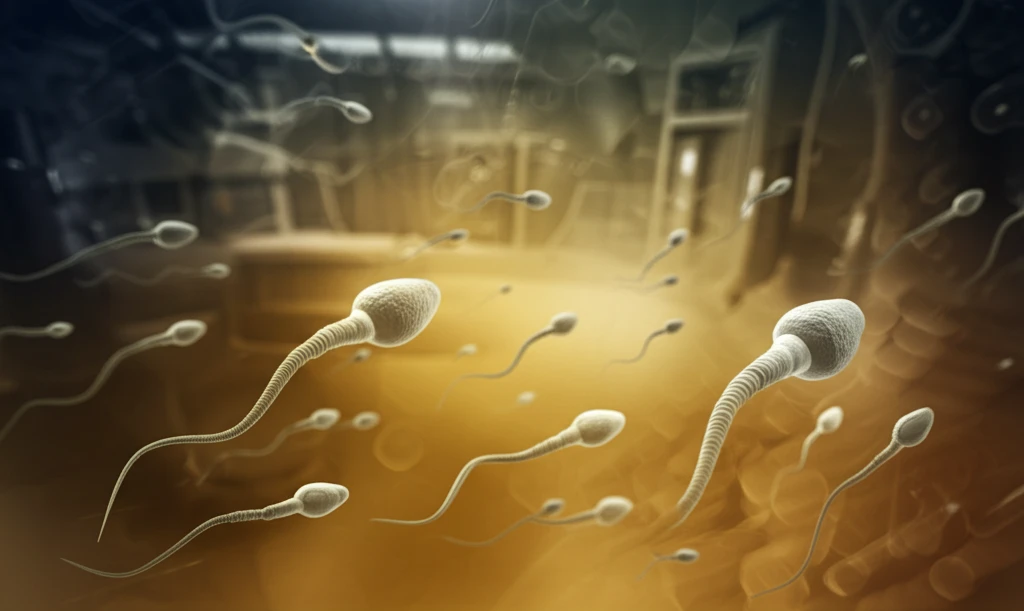
Is Your Semen the Canary in the Coal Mine? Understanding Male Fertility Issues
"Yellow semen syndrome in turkeys reveals potential insights into male reproductive health and fertility challenges, mirroring concerns that affect human populations."
Yellow semen syndrome (YSS) stands as a prevalent and concerning issue among male turkeys, significantly impacting their reproductive capabilities. Characterized by semen of diminished quality, YSS directly correlates with decreased fertility and reduced hatchability rates, presenting substantial challenges to poultry breeding programs. The syndrome's most notable feature is an elevated presence of serum albumin-like proteins within the seminal plasma, which has prompted researchers to investigate the role of albumin in the pathology of YSS and its potential effects on male reproductive health.
Despite the recognition of YSS and its impact on turkey populations, comprehensive knowledge regarding albumin expression within the reproductive tract and its correlation to YSS remains limited. The aim of a recent study was to bridge this gap by pinpointing the sites of albumin secretion and localization within the turkey reproductive system, especially in relation to YSS. By examining reproductive tissues and liver samples from turkeys with both white semen (WS) and YSS, researchers sought to analyze albumin mRNA expression and localization through advanced immunohistochemistry techniques.
Furthermore, the study extended its scope to encompass an in-depth analysis of albumin abundance in tissues, blood, and seminal plasma, employing sophisticated methods such as two-dimensional electrophoresis and western blot analysis. The findings revealed that albumin mRNA expression was detectable across all reproductive tract components, suggesting its widespread involvement in male reproductive processes. Interestingly, the most pronounced expression of albumin was observed in the ductus deferens of turkeys affected by YSS, indicating a potential link between this specific reproductive organ and the manifestation of the syndrome.
Decoding Albumin's Role in Male Fertility

The study sheds light on the intricate mechanisms underlying albumin secretion in the turkey reproductive tract, revealing the key sites and cellular participants involved. Testicular spermatids, Leydig cells, and myoid cells emerge as significant contributors to albumin synthesis and secretion within the testes. Meanwhile, the epithelial cells lining the epididymis and ductus deferens take center stage as the primary secretion sites along the reproductive tract. This nuanced understanding of albumin secretion unveils potential targets for future investigations aimed at unraveling the complexities of male fertility and reproductive disorders.
- Germ cells, including spermatocytes and spermatids, actively synthesize and secrete albumin within the turkey testis, underscoring its potential involvement in germ cell development and maturation.
- Leydig cells, responsible for testosterone production, also contribute to albumin secretion, hinting at a possible interplay between albumin and hormonal regulation in the male reproductive system.
- Epithelial cells lining the epididymis and ductus deferens emerge as the primary sites of albumin secretion along the reproductive tract, highlighting their critical role in shaping the seminal environment and supporting sperm maturation.
- The ductus deferens, in particular, exhibits heightened albumin secretion in YSS-affected turkeys, implicating its potential involvement in the syndrome's pathogenesis and its impact on semen quality.
Looking Ahead: Translational Implications for Male Fertility
By unraveling the complexities of albumin secretion in the turkey reproductive tract, this study lays a solid foundation for future research endeavors aimed at understanding the molecular underpinnings of YSS and its broader implications for male fertility. As researchers delve deeper into the regulatory mechanisms governing albumin secretion, they may uncover novel therapeutic targets for mitigating YSS and improving reproductive outcomes in turkeys. Moreover, the insights gained from this study may extend beyond avian species, offering valuable clues for understanding male fertility challenges in mammals, including humans. Continued exploration of albumin's role in male reproduction promises to yield significant advancements in reproductive medicine, benefiting both animal and human populations.
